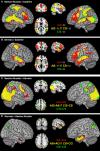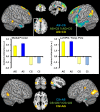Supramodal neural processing of abstract information conveyed by speech and gesture
- PMID: 24062652
- PMCID: PMC3772311
- DOI: 10.3389/fnbeh.2013.00120
Supramodal neural processing of abstract information conveyed by speech and gesture
Abstract
ness and modality of interpersonal communication have a considerable impact on comprehension. They are relevant for determining thoughts and constituting internal models of the environment. Whereas concrete object-related information can be represented in mind irrespective of language, abstract concepts require a representation in speech. Consequently, modality-independent processing of abstract information can be expected. Here we investigated the neural correlates of abstractness (abstract vs. concrete) and modality (speech vs. gestures), to identify an abstractness-specific supramodal neural network. During fMRI data acquisition 20 participants were presented with videos of an actor either speaking sentences with an abstract-social [AS] or concrete-object-related content [CS], or performing meaningful abstract-social emblematic [AG] or concrete-object-related tool-use gestures [CG]. Gestures were accompanied by a foreign language to increase the comparability between conditions and to frame the communication context of the gesture videos. Participants performed a content judgment task referring to the person vs. object-relatedness of the utterances. The behavioral data suggest a comparable comprehension of contents communicated by speech or gesture. Furthermore, we found common neural processing for abstract information independent of modality (AS > CS ∩ AG > CG) in a left hemispheric network including the left inferior frontal gyrus (IFG), temporal pole, and medial frontal cortex. Modality specific activations were found in bilateral occipital, parietal, and temporal as well as right inferior frontal brain regions for gesture (G > S) and in left anterior temporal regions and the left angular gyrus for the processing of speech semantics (S > G). These data support the idea that abstract concepts are represented in a supramodal manner. Consequently, gestures referring to abstract concepts are processed in a predominantly left hemispheric language related neural network.
Keywords: abstract semantics; emblematic gestures; fMRI; gesture; speech; tool-use gestures.
Figures




Similar articles
-
Social cues, mentalizing and the neural processing of speech accompanied by gestures.Neuropsychologia. 2010 Jan;48(2):382-93. doi: 10.1016/j.neuropsychologia.2009.09.025. Epub 2009 Sep 25. Neuropsychologia. 2010. PMID: 19782696
-
Neural Basis of Speech-Gesture Mismatch Detection in Schizophrenia Spectrum Disorders.Schizophr Bull. 2021 Oct 21;47(6):1761-1771. doi: 10.1093/schbul/sbab059. Schizophr Bull. 2021. PMID: 34050672 Free PMC article.
-
Memory effects of speech and gesture binding: cortical and hippocampal activation in relation to subsequent memory performance.J Cogn Neurosci. 2009 Apr;21(4):821-36. doi: 10.1162/jocn.2009.21053. J Cogn Neurosci. 2009. PMID: 18578601
-
Hearing and seeing meaning in speech and gesture: insights from brain and behaviour.Philos Trans R Soc Lond B Biol Sci. 2014 Sep 19;369(1651):20130296. doi: 10.1098/rstb.2013.0296. Philos Trans R Soc Lond B Biol Sci. 2014. PMID: 25092664 Free PMC article. Review.
-
The neural basis of hand gesture comprehension: A meta-analysis of functional magnetic resonance imaging studies.Neurosci Biobehav Rev. 2015 Oct;57:88-104. doi: 10.1016/j.neubiorev.2015.08.006. Epub 2015 Aug 10. Neurosci Biobehav Rev. 2015. PMID: 26271719 Review.
Cited by
-
Evidence for the Concreteness of Abstract Language: A Meta-Analysis of Neuroimaging Studies.Brain Sci. 2021 Dec 28;12(1):32. doi: 10.3390/brainsci12010032. Brain Sci. 2021. PMID: 35053776 Free PMC article. Review.
-
Perceived communicative intent in gesture and language modulates the superior temporal sulcus.Hum Brain Mapp. 2016 Oct;37(10):3444-61. doi: 10.1002/hbm.23251. Epub 2016 May 30. Hum Brain Mapp. 2016. PMID: 27238550 Free PMC article.
-
Multimodal integration of spontaneously produced representational co-speech gestures: an fMRI study.Lang Cogn Neurosci. 2017;32(2):158-174. doi: 10.1080/23273798.2016.1245426. Epub 2016 Oct 28. Lang Cogn Neurosci. 2017. PMID: 29130054 Free PMC article.
-
A Multimodal Speech-Gesture Training Intervention for Patients With Schizophrenia and Its Neural Underpinnings - the Study Protocol of a Randomized Controlled Pilot Trial.Front Psychiatry. 2020 Mar 6;11:110. doi: 10.3389/fpsyt.2020.00110. eCollection 2020. Front Psychiatry. 2020. PMID: 32210849 Free PMC article.
-
Perceived Conventionality in Co-speech Gestures Involves the Fronto-Temporal Language Network.Front Hum Neurosci. 2017 Nov 30;11:573. doi: 10.3389/fnhum.2017.00573. eCollection 2017. Front Hum Neurosci. 2017. PMID: 29249945 Free PMC article.
References
LinkOut - more resources
Full Text Sources
Other Literature Sources
Research Materials

